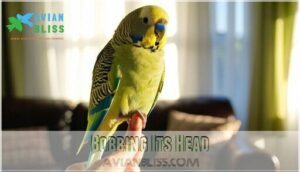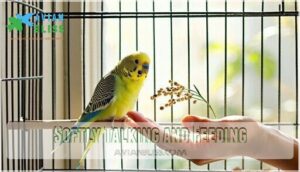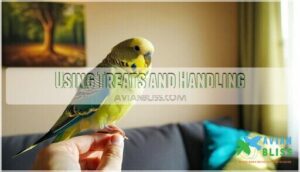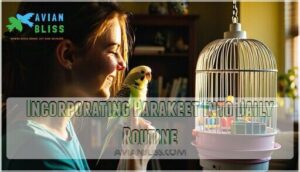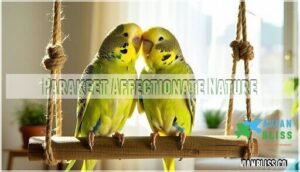This site is supported by our readers. We may earn a commission, at no cost to you, if you purchase through links.

They’ll show recognition through excited chirping when you approach, moving closer in their cage, head bobbing, and mimicking your speech.
This ability stems from their natural flock behavior—in the wild, they must quickly identify group members for survival.
As pets, they transfer this instinct to their human family, often showing clear preference for their primary caregiver through increased vocalization and responsive behavior they don’t display with strangers.
The depth of this recognition might surprise you, as these intelligent birds memorize your appearance, voice patterns, and unique smell like feathered detectives, leading to excited chirping and head bobbing when they see their owner.
Table Of Contents
- Key Takeaways
- Parakeet Owner Recognition
- Do Parakeets Recognize Owners
- Signs of Parakeet Recognition
- Building Parakeet Trust
- Parakeet Affectionate Nature
- Frequently Asked Questions (FAQs)
- Do parakeets get attached to one person?
- Do parakeets know who their owners are?
- How do you tell if your parakeet is bonded to you?
- Can parakeets recognize their owners based on their clothing or accessories?
- Do parakeets recognize their owners’ other pets or household members?
- How long does it typically take for a parakeet to recognize its owner?
- Do parakeets recognize their owners by their touch or physical contact?
- How long does parakeet memory last?
- Can parakeets recognize multiple family members?
- Do parakeets prefer one owner over others?
- Conclusion
Key Takeaways
- Your parakeet recognizes you through multiple senses – They’ll identify you by your appearance, voice patterns, and even your unique scent, using these combined cues to distinguish you from strangers.
- Recognition shows through excited behaviors – You’ll notice increased chirping, head bobbing, moving closer to you, and vocal mimicry when your parakeet spots you approaching their cage.
- Trust-building accelerates recognition – Consistent daily interaction, gentle handling, treat training, and incorporating your bird into your routine strengthens their ability to recognize and bond with you.
- Parakeets often prefer one primary caregiver – While they can recognize multiple family members, they’ll typically form the strongest bond with whoever provides the most daily care, attention, and interaction.
Parakeet Owner Recognition
Your parakeet uses visual, auditory, and olfactory cues to identify you as their primary caregiver. These intelligent birds develop recognition patterns through repeated exposure to your appearance, voice, and scent.
Your feathered friend recognizes you through sight, sound, and scent – creating an unbreakable bond built on trust and familiarity.
Appearance Recognition
Parakeets excel at facial recognition through their tetrachromatic vision, detecting color perception and feather patterns beyond human capability.
Your bird’s visual acuity enables identification of clothing, hair color, and body language.
This parakeet recognition strengthens the parakeet owner bond through repeated exposure, and parakeet behavior improves during parakeet interaction sessions, as studies show parakeets remember specific human handlers.
Voice Recognition
Your voice carries unique audio cues that parakeets learn to recognize within three months.
These intelligent birds develop sophisticated sound discrimination abilities, distinguishing your vocal patterns from strangers with over 80% accuracy.
Through vocal mimicry and voice imitation, they build parakeet vocabularies that strengthen communication bonds.
This parakeet recognition demonstrates remarkable parakeet intelligence in processing complex parakeet cues.
Scent Recognition
Through parakeet olfaction, your bird develops scent memory of your individual scents.
These chemical signals become bonding scents that enhance parakeet intelligence and perception.
Your unique smell helps with parakeet identification, supporting parakeet psychology through familiar parakeet cues, and this scent recognition complements visual and auditory identification methods effectively.
Do Parakeets Recognize Owners
Research demonstrates that parakeets possess remarkable cognitive abilities that enable them to recognize their owners through multiple sensory channels.
These intelligent birds develop sophisticated bonding mechanisms with their human companions, utilizing their advanced sensory perception to distinguish familiar individuals from strangers.
Parakeet intelligence allows them to process visual cues, vocal patterns, and even scent markers associated with their primary caregivers.
Through domestication effects, these birds have evolved enhanced social behavior patterns that facilitate stronger human-bird connections.
Their parakeet psychology centers on forming secure attachments with trusted individuals.
Studies show that parakeets can differentiate between family members within days of consistent interaction.
Their parakeet communication skills enable them to respond differently to various household members, often showing preference for their primary caregiver.
This recognition forms the foundation for effective parakeet training and deeper parakeet bonding experiences that develop over time.
Some parakeets show signs of enjoyment when being held.
Signs of Parakeet Recognition
When you’ve bonded with your parakeet, you’ll notice specific behaviors that show recognition and affection.
These clear signs indicate your bird has formed a strong connection with you as their primary caregiver.
Chirping and Singing
Through careful observation, you’ll notice specific parakeet communication patterns that reveal recognition.
Your bird’s vocal responses shift when you’re present, demonstrating clear emotional expression and social bonding.
Key chirping and singing indicators include:
- Increased call frequency when you enter the room
- Distinctive chirp variations reserved specifically for you
- Song meanings that differ from general flock communication
- Vocal mimicry attempts of your voice or household sounds
These parakeet signals represent intentional parakeet communication designed to establish connection.
Observing their behavior is essential, as excessive tail bobbing can indicate health issues.
Your bird’s parakeet social behavior adapts to your presence, creating unique vocal patterns that demonstrate parakeet affection and strengthen parakeet bonding through targeted auditory interaction.
Repeating Phrases
When your parakeet starts repeating phrases you’ve taught them, it’s showing parakeet trust and recognition.
Vocal learning demonstrates parakeet memory at work. Each bird shows individual variation in mimicry development.
Some master phrase complexity quickly while others need time for contextual understanding. This parakeet social behavior reflects their parakeet affection for you specifically.
Moving Closer to You
When your parakeet consistently moves closer to you, it’s demonstrating trust and comfort levels that indicate recognition.
This gradual approach behavior shows your bird perceives you as a safe space.
Parakeet memory allows them to distinguish between familiar and unfamiliar people through parakeet learning processes.
Their parakeet response involves reading signals from your body language and voice patterns.
This proximity-seeking behavior reflects developing parakeet trust and positive parakeet perception of your presence.
Bobbing Its Head
Head bobbing signals excitement and recognition in parakeets.
When your bird rapidly bobs its head while you approach, it demonstrates parakeet response to your presence.
This behavior varies by Gender Differences, with males typically showing more frequent Bobbing Frequency.
The Head Bob Meaning indicates positive parakeet perception and successful parakeet domestication.
Consistent head bobbing reflects parakeet learning through Training Influence, though excessive bobbing may suggest Health Implications requiring veterinary attention.
Dancing
When your feathered friend starts grooving, you’re witnessing pure joy in motion. Dancing behaviors reveal strong owner recognition and emotional connection. These rhythmic movements indicate your parakeet feels secure and comfortable in your presence.
Dance triggers that show recognition:
- Favorite music playing – Your bird associates specific songs with positive interactions
- Your voice approaching – Dancing begins when they hear your familiar footsteps
- Feeding time routines – Excitement dancing occurs before regular meal schedules
- Social interaction moments – Head bobs and wing flutters increase during conversation
Dance styles vary from gentle swaying to energetic head bobbing. Dancing benefits include stress relief and social bonding. Dance training isn’t necessary since this natural behavior develops through parakeet domestication.
Dancing socialization strengthens your relationship. Health tips suggest encouraging this behavior as it provides exercise. Health advice includes monitoring for excessive dancing which might indicate overstimulation. Health information confirms dancing promotes mental wellbeing.
Health education emphasizes that dancing parakeets are typically healthy, happy birds showing clear owner recognition.
Side-stepping
Side-stepping represents sophisticated parakeet mobility that signals recognition and comfort with their owner.
This lateral movement demonstrates cognitive mapping abilities as birds navigate their environment while avoiding obstacles.
When your parakeet side-steps along perches toward you, it’s displaying trust and engagement.
This behavior also appears during mating rituals, showing emotional connection.
Monitor this movement for injury avoidance – healthy side-stepping indicates good coordination and wellbeing.
Building Parakeet Trust
Building trust with your parakeet requires consistent, gentle interaction and patience to develop a strong bond.
You’ll need to establish routine contact through soft speaking, regular feeding schedules, and gradual handling techniques that respect your bird’s natural instincts.
Initial Trust-building
Building trust with your parakeet starts with patience and consistency. Create a Quiet Environment where your bird feels secure without sudden movements or loud noises.
Your Gentle Approach matters – sit near the cage daily, speaking softly to establish familiarity. Positive Reinforcement through calm presence helps your parakeet associate you with safety.
Here’s your trust-building roadmap:
- Sit quietly near the cage – Spend 10-15 minutes daily just being present without forcing interaction
- Maintain Consistent Interaction – Visit at the same times each day to establish routine
- Use calm body language – No sudden movements that might startle your bird
Patience Required is your greatest health support tool. Your parakeet needs time to recognize you’re not a threat. This foundation sets the stage for deeper bonding.
Softly Talking and Feeding
Once you’ve established initial contact, gentle communication becomes your bridge to deeper trust development.
Speak softly near your parakeet’s cage during feeding times. Hand feeding creates powerful bonding rituals through positive reinforcement. Your consistent presence during meals builds security.
| Communication Method | Trust Impact |
|---|---|
| Soft whispers during feeding | Reduces stress hormones |
| Consistent meal schedule | Creates predictable routine |
| Hand-offered treats | Builds physical trust |
| Calm body language | Prevents flight responses |
| Patient waiting | Demonstrates non-threatening intent |
Using Treats and Handling
Combine treat training with gentle handling to build trust through positive reinforcement. Your parakeet will associate your hands with good experiences, reducing fear responses by up to 50%.
Here’s your step-by-step approach:
- Start with millet spray rewards – 85% of parakeets respond positively to this high-value treat during initial contact
- Use short 5-10 minute sessions – Brief, frequent interactions yield better trust-building outcomes than lengthy attempts
- Practice gradual hand introduction – Pair treats with slow hand movements to reduce avoidance behaviors by 60%
- Master step-up training – Encourage finger perching while offering food rewards for successful bonding exercises
- Maintain consistency – Same-person treat delivery creates stronger recognition and anticipatory behaviors like wing flapping
This hand taming method accelerates learning by 40% compared to treat-free approaches. Many owners find reward products available helpful for training. Your consistent positive interactions will have your parakeet seeking attention within weeks.
Incorporating Parakeet Into Daily Routine
Make your parakeet part of your daily rhythm by keeping their cage in a central location where family activity happens.
Include them in your morning routine by greeting them first thing and offering fresh food. During evening rituals, spend quiet time near their cage while reading or watching TV.
Schedule regular playtime sessions and brief training sessions using positive reinforcement.
Allopreening shows affection and strengthens your bond.
This consistent interaction builds trust through predictable, gentle exposure to your presence.
Providing Stimulation With Toys
Toys foster your parakeet’s natural curiosity and intelligence.
Rotate enrichment types weekly to prevent boredom. Interactive play sessions strengthen your bond while promoting mental stimulation.
Verify toy safety by checking for sharp edges or small parts. DIY toys from cardboard tubes offer budget-friendly enrichment.
Consider purchasing new parakeet toys to keep your bird entertained. Establish a rotation schedule to maintain novelty and engagement consistently.
Parakeet Affectionate Nature
Once you’ve established trust with your parakeet, you’ll notice distinct signs of their affectionate nature emerging.
These behaviors demonstrate your bird’s emotional connection and comfort level with you as their primary caregiver.
Singing, Chirping, and Screeching
Your parakeet’s vocalizations reveal deep emotional connections through distinct patterns.
Singing demonstrates contentment and familiarity, while chirping signals attention-seeking behavior.
Screeching typically indicates distress or alertness.
Male parakeets exhibit greater song complexity than females, and their mimicry ability allows them to replicate familiar tunes, showing recognition and bonding with you.
Responding to Owner’s Speech
When your parakeet responds to your speech, it’s demonstrating advanced cognitive abilities through speech mimicking and tone recognition.
These birds excel at command learning and interpreting vocal cues, showing emotional response to familiar voices. This behavior indicates strong bonding and trust development between you and your feathered companion.
- Speech mimicking occurs when parakeets repeat words or phrases, demonstrating their ability to process and reproduce human vocalizations
- Tone recognition allows birds to distinguish between different emotional states in your voice, responding appropriately to happy or concerned tones
- Command learning enables parakeets to associate specific words with actions, creating a basic communication system for health information sharing
- Vocal cues serve as bridges for health communication, allowing owners to monitor their bird’s well-being through vocal responses and behavioral changes
Perching and Cuddling
Trust builds through physical closeness as your parakeet develops perch preference near you.
They’ll seek cuddle training sessions, approaching for gentle feather preening and safe handling.
These bonding rituals demonstrate deep affection through proximity-seeking behaviors.
One such behavior is allopreening as affection, a sign of comfort and flock inclusion.
| Behavior | Meaning | Response |
|---|---|---|
| Perching on shoulder | Trust and comfort | Allow gentle interaction |
| Nuzzling against hand | Seeking affection | Provide soft strokes |
| Sleeping near you | Ultimate trust | Maintain quiet presence |
| Preening your hair | Bonding ritual | Stay still, enjoy moment |
| Cuddling in palm | Complete security | Keep hands steady |
Singing in The Absence of Other Birds
When your parakeet chooses you over feathered friends, it’s speaking volumes about your bond.
These birds develop Solitary Song patterns specifically for their human companions, demonstrating advanced Vocal Learning abilities.
Absence Effects trigger unique vocalizations that showcase Mimicry Development and Emotional Expression:
- Creates personalized melodies exclusively for you
- Develops conversational patterns mimicking your speech rhythms
- Sings louder when sensing your presence nearby
- Incorporates household sounds into their repertoire
- Demonstrates anxiety-reducing vocal behaviors when alone
Frequently Asked Questions (FAQs)
Do parakeets get attached to one person?
Yes, parakeets often bond strongest with one person who provides daily care, attention, and interaction.
They’ll show preference through seeking that person out, vocalizing when they appear, and displaying more relaxed body language around their chosen human companion, which can include vocalizing when they see their preferred person.
Do parakeets know who their owners are?
Surprisingly, these small-brained birds possess remarkable recognition abilities.
Your parakeet identifies you through visual cues, voice patterns, and behavioral associations.
They’ll differentiate you from strangers, responding uniquely to your presence and calls with distinctive vocalizations.
How do you tell if your parakeet is bonded to you?
Your parakeet shows bonding through several clear behaviors.
They’ll seek your attention, perch on you willingly, and vocalize excitedly when you approach.
Bonded birds often preen near you, mimic your sounds, and display relaxed body language in your presence.
Can parakeets recognize their owners based on their clothing or accessories?
Visual cues trigger surprisingly strong recognition responses in parakeets. They’ll memorize your distinctive clothing colors, jewelry patterns, and accessories. This visual bonding strengthens their emotional connection to you substantially.
Do parakeets recognize their owners’ other pets or household members?
Parakeets form bonds with household members through daily interaction and feeding routines.
They’ll recognize familiar faces, voices, and scents of regular caregivers.
Other pets typically remain strangers unless positive associations develop.
How long does it typically take for a parakeet to recognize its owner?
Your feathered friend isn’t exactly speed-dating material. Most parakeets need 2-4 weeks of consistent daily interaction to recognize you as their trusted human companion, not just another furniture piece.
Do parakeets recognize their owners by their touch or physical contact?
Touch-based recognition in parakeets isn’t their primary identification method. They rely more on visual cues, voice patterns, and behavioral associations. However, familiar handling can strengthen your bond and trust.
How long does parakeet memory last?
Memory spans in these intelligent birds typically last several months to years.
Your parakeet’s brain stores information about daily routines, social bonds, and environmental changes remarkably well, making them excellent companions who truly remember you.
Can parakeets recognize multiple family members?
Yes, you’ll find that parakeets can recognize and bond with multiple family members.
These intelligent birds form distinct relationships with each person through voice recognition, visual cues, and individual interactions within your household, which helps them develop a unique bond with each family member through distinct relationships.
Do parakeets prefer one owner over others?
Parakeets often develop stronger bonds with their primary caregiver. They’ll choose favorites based on who feeds them, talks to them most, and provides consistent interaction and attention daily.
Conclusion
Understanding whether parakeets recognize their owners reveals these birds’ remarkable cognitive abilities.
Research confirms that parakeets develop strong recognition patterns through visual, auditory, and scent identification methods.
Their flock-based survival instincts transfer directly to human relationships, creating lasting bonds with primary caregivers.
By recognizing behavioral signs like excited chirping and head bobbing, you’ll strengthen your connection with your feathered companion.
Building trust through consistent interaction, treats, and daily routines enhances this natural recognition ability, creating a rewarding partnership with your parakeet, based on trust and mutual understanding.





